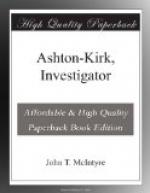“Worth two thousand if it’s worth a cent,” appraised Osborne.
“If the criminal had meant robbery these things would unquestionably have been taken,” commented the young coroner. “Eh, Curran?”
“That is a very safe rule to go by, Mr. Stillman,” replied his assistant, with the utmost stolidity.
Through his big lenses the coroner gazed curiously at the bronze haft protruding from the dead man’s chest.
“A bayonet,” said he. “Not a common weapon in a crime like this. In fact, I should say it was rather in the nature of an innovation.”
“It probably belonged in Hume’s stock,” suggested Osborne. “There seems to be about everything here.”
But Stillman shook his head.
“We have already about concluded that the intention of the criminal was not robbery,” stated he. “And now, if we make up our minds that the bayonet belonged to Hume—that the assassin, in point of fact, came here without a weapon—it must be that he did not intend murder either.”
“Maybe he didn’t,” ventured Osborne. “There might have been a sudden quarrel. The person who struck that blow may have grabbed up the first competent looking thing that came to his hand.”
Stillman turned to Ashton-Kirk.
“That sounds reasonable enough, eh?”
“Very much so,” replied Ashton-Kirk.
“A bayonet is a most unusual weapon,” said the coroner thoughtfully, readjusting his glasses. “And I think it would be a most awkward thing to carry around with one. Therefore, it would be a most unlikely choice for an intending assassin. I am of the opinion,” nervously, “that we may safely say that it was a sudden quarrel which ended in this,” and he gestured with both hands toward the body.
The safe doors were tried and found locked; a cash register was opened and found to contain what had been apparently the receipts of the day before. An examination of the cabinets and cases disclosed hundreds of ancient coins and other articles the value of which must have been heavy. But their orderly array had not been disturbed. A long curtain of faded green material hung from the wall at one side, as though to screen something from the sunlight and dust.
“What have we here?” said the coroner.
He stepped across the store and whisked the curtain aside. A large gilt frame was disclosed; and from it hung the slashed remains of a canvas.
“Hello!” exclaimed Osborne, with interest. “This begins to look like one of the old affairs that they say Hume’s been mixed up in. Somebody’s tried to cut that picture from the frame.”
They examined it carefully. A keen knife had been run around the top and both sides, close to the frame. The painting hung down, its gray back displayed forlornly.
Stillman regarded it with great satisfaction.
“Here,” said he, “we at least have a possible motive.”
Ashton-Kirk took a twisted walking stick from a rack, and with the end of it, raised the slashed canvas so that its subject could be seen. It was a heroic equestrian figure of an officer of the American Revolution. His sword was drawn; his face shone with the light of battle.




